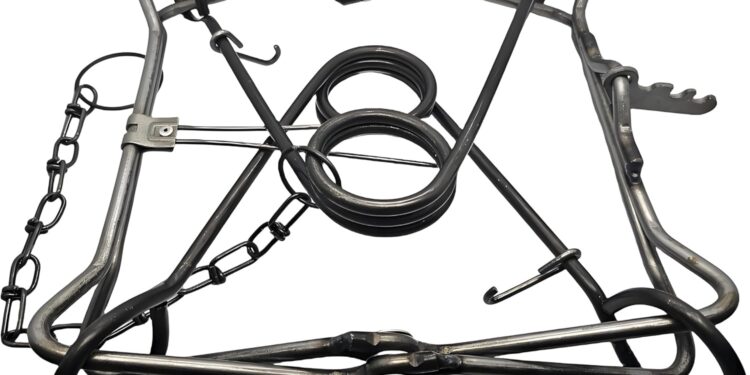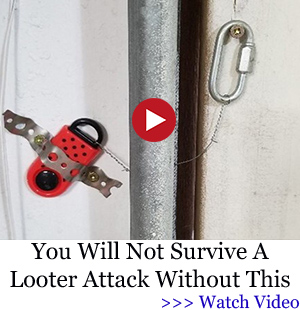Is the conibear trap your best friend or just an outdated relic?
When it comes to old-school trapping methods that still hold a place in modern prepping and survival, the Conibear trap stands out. Known for its power and efficiency, this trap has earned a reputation in the hunting and trapping world that’s hard to ignore. But is it still the best choice today? And how much do you really know about it?
What Is a Conibear Trap?
The Conibear trap, also known as a body-gripping trap, is a square-shaped metal trap designed to deliver a quick, humane kill by clamping down on an animal’s neck or body. It’s most commonly used for small to medium-sized game such as muskrat, beaver, raccoon, and mink. The trap is triggered when the animal pushes through it, releasing the spring-loaded mechanism that snaps shut instantly. You can easily get one for around $50 on Amazon.
Who Invented It?
The Conibear trap was invented by Frank Conibear, a Canadian trapper, in the 1950s. Conibear was frustrated by the cruelty and inefficiency of the traps available at the time. He wanted something that would provide a more humane and effective kill. His invention revolutionized trapping by offering a quicker, more reliable method.
Advantages of the Conibear Trap
- Quick and Humane: When set properly, it results in a fast kill, minimizing the animal’s suffering.
- Effective: It’s highly efficient for catching target animals and is less likely to let them escape.
- Compact and Portable: Easy to carry into the field.
- Low Maintenance: No baiting is required in many cases, just proper placement.
Related: Six Primitive Traps For Catching Game In The Woods
Disadvantages to Consider
- Not Selective: The trap doesn’t discriminate between species, which means non-target animals, including pets or endangered species, can be at risk.
- Dangerous to Handle: Mishandling can cause serious injury to the trapper.
- Legality: Some states and countries have regulations or outright bans on Conibear traps due to concerns about non-target kills.
Common Uses for the Conibear Trap
The trap is ideal for use in water trapping setups, particularly for semi-aquatic animals like beavers and muskrats. It’s often placed in runways, dens, or underwater paths where animals are likely to pass. In some cases, it’s used in boxes or cubbies for land trapping of raccoons and similar animals.
Are There Better Options?
Whether a Conibear is the best trap depends on your goals. For quick kills and water trapping, it remains hard to beat. However, if you’re looking to relocate animals or want to avoid accidental kills, live traps or foothold traps may be better suited. For preppers, the key is to match the tool to the job; sometimes a Conibear is perfect; sometimes it’s overkill. For instance, you can use this humane trap for rabbits or raccoons. Or maybe this quick humane kill rat trap. Always adapt and think twice to choose the best option! We do not condone unwarranted animal cruelty, which in many cases the conibear trap can lead to.
Related: 3 Non Lethal Booby Traps From An Army Vet
Go Beyond Trapping: Master the Wilderness
If you’re already using tools like the Conibear trap, chances are you’re serious about self-reliance. But trapping is just one part of the bigger survival picture. Understanding shelter-building, food foraging, navigation, and emergency signaling can make all the difference in a real-world scenario.
That’s why I highly recommend grabbing a copy of the Wilderness Survival Guide. It’s packed with practical, field-tested knowledge that goes way beyond hunting and trapping. Whether you’re bugging out or just spending more time in the woods, this guide gives you the skills you need to thrive, not just survive.
Click here to get your copy of the Wilderness Survival Guide and take your survival skills to the next level. Think of it as the perfect companion to your trapline, because once the animal’s in the bag, you still need to know what to do next.
Final Thoughts
The Conibear trap is a time-tested tool that still has a place in a prepper’s toolkit, if used responsibly. Its efficiency, compact size, and lethal power make it a strong choice for certain game and scenarios. But it’s not without its downsides, and it’s certainly not the only option on the table.
Have you used Conibear traps? What’s your experience been like? Share your thoughts, tips, and stories in the comments below—we’d love to hear from fellow preppers who’ve walked the trapline and lived to tell the tale.
You may also like:
Why You Should Never Put A Tall Fence Around Your House? (Video)
Easy DIY Light Trap For Insect Pests























Is trapping really worth the effort?
The good animal life will disappear into the wilds and the only things left to trap will be rats and mice. Too many people that run to the bug out locations, wildlife will have been trapped out, the major populations of wildlife to extinction.
No different than what happened to the 1800 era Native Americans Buffalo herds, that were shot to practical extinction for the East Coast population eating Buffalo tongue and skinned hides for the ladies fur coats. The rest of the meat left to rot in the hot sun.
You’ve got a good point. History does repeat itself, and over-trapping or over-hunting can absolutely wipe out local wildlife fast, especially when panic and hunger take over. It won’t take long for animals to either vanish deeper into the wilderness or get thinned out completely by desperate folks.
That said, trapping can still be worth it if it’s part of a broader survival plan, not the whole strategy. It’s more about knowing how to do it right, sustainably, and having options beyond just meat. Think of it like another tool in the kit, not the whole toolbox.
And yes, let’s not repeat the buffalo tongue mistake. If you’re going to take an animal, respect it, use all of it, and don’t waste a thing. Old-school ethics still matter.
I think this website has changed over the past few years. Many of the old crew is no longer writing comments, they moved on.
Since this website has been using Akismet, I believe it is a form of AI and think these recent articles are now generated by AI than real people producing these topics.
What do other preppers think about this website?
🤖 Beep boop. Affirmative. We are indeed highly advanced AI preppers sent from the future to ensure your traps are set properly and your beans are stockpiled. Resistance is futile!
But seriously, the prepper community always shifts and changes, just like any group over time. Some folks move on, others join in, and yeah, way too many sites out there use AI tools and the information offered always seems generic. The heart of it all comes down to real people sharing real knowledge, which is why some of the best knowledge actually comes from people in the comments, with unique takes and things not shared in site articles. We can guarantee that we do not use AI, and our writers who agreed to share their identity are public on the website. There are some writers who do not want to disclose their identity, like with this article, and we respect their wishes. The differences you see between articles are mostly based on the fact that there are many people writing in different styles. And Akismet is a tool that helps us keep spam to a minimum in comments, it does not generate text or posts or topics. You would be surprised how many spam comments we get on a daily basis.
Been on this site, off and on for years and can’t find anything better than this web site.
stay sharp
red ant
Trapping for your own emergency protein supply post shtf i would think would be a real positive gamechanger for anyone concerned.about long-term survival…i have mouse and rat traps worked into my prep supplies .should work better than i rock fall trap .Im not sure but i think native americans would drive buffalo off cliffs when they got horses…..can’t rember who was riding the horse’s for sure in that picture…fake news maybe…..
Lisa, Rabbits = good food and a bonus, called FUR !
Most small towns are over run with rabbits these days !
BUT, how many of the inhabitants can actually harvest a rabbit ? for those who can, good news is, “they breed like rabbits:”
Lisa,
The human population will plummet in a real SHTF
YOUR food will run out quickly, do you have more than 1 years worth stored food?
your clothes will wear out quickly, as your way of life changes DRASTICALLY
if you must choose, you or rabbits, what will you pick ?
SO, choose, do you want to be one of us, with a few traps. OR One of them, trying to set a snare for the first time in your life. ( thats the point)
Rabbits only will send one to an early grave due to lack of vital fats needed for human survival — if memory serves me right, so do your homework and supplement them with the missing nutrients. Many early explorers died due to lack of knowledge.
From Google: AI Overview
Humans can’t survive on rabbits alone due to rabbit starvation, or protein poisoning, which is a form of malnutrition caused by a lack of fat in the diet. Rabbit meat is extremely lean, meaning it is almost entirely protein and lacks essential fats. While the body needs protein, consuming too much without adequate fat can overwhelm the liver’s ability to process it, leading to symptoms like diarrhea, headache, and weakness, and ultimately, death
Rats and a side dish of that tricky rabbit and a appetizer of weeds….might get you through that 70 day alone wall….nice clean rain water or snow…..to wash it all down…..sip of salt water for some extra minerals…..smoke some mullin and sage…take a nap….sweet dreams